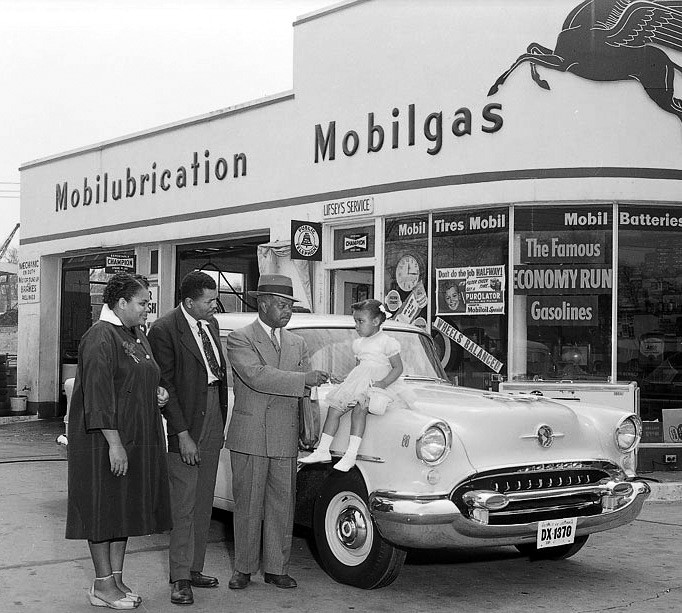 If you caught the 2018 film Green Book, you may have noticed a certain iconic roadside stop made its appearance about halfway through the film. That’s right – the film’s lead characters, pianist Dr. Don Shirley (Mahershala Ali) and his driver Tony Lip (Viggo Mortensen), make a Stuckey’s stop for a bite to eat during the film’s 1962 road trip across the American South. And it’s no coincidence that Stuckey’s made its way into the film, either. That’s because Stuckey’s founder, W.S. Stuckey, often said that “every traveler is a friend” … and that means Stuckey’s has always been a place for roadtrippers of any skin color.
If you caught the 2018 film Green Book, you may have noticed a certain iconic roadside stop made its appearance about halfway through the film. That’s right – the film’s lead characters, pianist Dr. Don Shirley (Mahershala Ali) and his driver Tony Lip (Viggo Mortensen), make a Stuckey’s stop for a bite to eat during the film’s 1962 road trip across the American South. And it’s no coincidence that Stuckey’s made its way into the film, either. That’s because Stuckey’s founder, W.S. Stuckey, often said that “every traveler is a friend” … and that means Stuckey’s has always been a place for roadtrippers of any skin color.
Here’s the Green Book story …
–
The spread of the automobile in the 1930s brought with it a new kind of freedom to America — the freedom of the open road. Unfortunately, that freedom wasn’t afforded to every American as Black drivers were often discriminated against thanks to Jim Crow laws — state and local laws that enforced racial segregation in the Southern United States. As a result, Black travelers faced many difficulties when they traveled America’s highways, such as white-owned motels and restaurants refusing to serve them or white-owned garages refusing to repair their vehicles. Black travelers were also met with threats of physical violence if they weren’t out of the “sundown towns” — all-white cities, towns, or neighborhoods — by dusk.
In the mid-1930s, however, a black postal worker from Harlem, New York by the name of Victor Hugo Green created a guidebook that would make it a little easier for Black Americans to enjoy the same road trip lifestyle as their white counterparts.
After seeing his Jewish friend reading a book that listed popular places that Jews could stay to get away from it all in the Catskills, Green said to him, “You know, Black people could use a book like that.” So, he created one he eponymously called, The Green Book.
What’s more, The Negro Motorist’s Green Book not only helped Black travelers avoid racism and humiliation, but it also helped black entrepreneurs set up their own roadside businesses. (For example, at the time, Esso (later Exxon) franchised gas stations to African Americans, when other companies refused.) Thus, it created a sort of “parallel universe” for black travelers to not only navigate through the Jim Crow South, but also through the North and West where discrimination was sometimes just as prevalent. Moreover, Civil Rights activists also used the book, often holding their group meetings at Black-owned hotels, motels and restaurants.
In the very first printing of the Green Book, Victor Hugo Green wrote in the introduction:
“There will be a day sometime in the near future when this guide will not have to be published. That is when we as a race will have equal rights and privileges in the United States.”
Though Green would die in 1960 and not live to see it, that day did come with the signing of the Civil Rights Act of 1964 which ended the Jim Crow laws that had made the Green Book necessary. The last Green Book would be published in 1966, exactly 30 years after Victor Green started it.
Since then, the book fell into obscurity … until the film came out and people started getting interested in it again. If you get the chance, watch it … and remember, at Stuckey’s, every traveler has always been a friend!
Stuckey’s – We’re Making Road Trips Fun Again!
Whether your next road trip is by car or by rail, it’s not really a road trip without taking Stuckey’s along. From our world famous Stuckey’s Pecan Log Rolls to our mouthwatering Hunkey Dorey, Stuckey’s has all the road trips snacks you’ll need to get you where you’re going.
For all of the pecany good treats and cool merch you’ll need for your next big road adventure, browse our online store now!
Stuckey’s – We’re Making Road Trips Fun Again!
